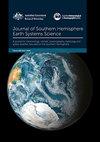Response time of temperature measurements at automatic weather stations in Australia
IF 3.6
4区 地球科学
Q1 Earth and Planetary Sciences
引用次数: 0
Abstract
Bureau of Meteorology automatic weather stations (AWS) are employed to record 1-min air temperature data in accord with World Meteorological Organization recommendations. These 1-min values are logged as the value measured for the last second in each minute. The Bureau explains that this is appropriate because the inherent measurement system time constant means the 1-s data are not instantaneous, but are an average smoothed over the previous 40–80s. To test this proposition in the field air temperature data were measured at 1-Hz at two Bureau AWS sites between April and June 2018. The frequency distribution of the differences between each 1-s value and the 60-s average centred on that value provided information on the overall measurement system response time constant. Expressed in terms of an e-folding measurement system response time, the data from the two measurement systems studied yielded response times in the range 50–150s, largely consistent with the Bureau’s explanation.澳洲自动气象站温度测量的响应时间
根据世界气象组织的建议,使用气象局自动气象站(AWS)记录1分钟气温数据。这些1分钟的值被记录为每分钟最后一秒的测量值。该局解释说,这是合适的,因为固有的测量系统时间常数意味着1秒的数据不是瞬时的,而是在过去40 - 80秒的平均平滑。为了在现场测试这一命题,我们在2018年4月至6月期间在两个AWS站点以1 hz的频率测量了空气温度数据。每个1秒值和60秒平均值之间的差值的频率分布以该值为中心,提供了有关整个测量系统响应时间常数的信息。以电子折叠测量系统的反应时间表示,所研究的两个测量系统的数据的反应时间在50 - 150秒之间,与本局的解释基本一致。
本文章由计算机程序翻译,如有差异,请以英文原文为准。
求助全文
约1分钟内获得全文
求助全文
来源期刊

Journal of Southern Hemisphere Earth Systems Science
Earth and Planetary Sciences-Oceanography
CiteScore
8.10
自引率
8.30%
发文量
0
审稿时长
>12 weeks
期刊介绍:
The Journal of Southern Hemisphere Earth Systems Science (JSHESS) publishes broad areas of research with a distinct emphasis on the Southern Hemisphere. The scope of the Journal encompasses the study of the mean state, variability and change of the atmosphere, oceans, and land surface, including the cryosphere, from hemispheric to regional scales.
general circulation of the atmosphere and oceans,
climate change and variability ,
climate impacts,
climate modelling ,
past change in the climate system including palaeoclimate variability,
atmospheric dynamics,
synoptic meteorology,
mesoscale meteorology and severe weather,
tropical meteorology,
observation systems,
remote sensing of atmospheric, oceanic and land surface processes,
weather, climate and ocean prediction,
atmospheric and oceanic composition and chemistry,
physical oceanography,
air‐sea interactions,
coastal zone processes,
hydrology,
cryosphere‐atmosphere interactions,
land surface‐atmosphere interactions,
space weather, including impacts and mitigation on technology,
ionospheric, magnetospheric, auroral and space physics,
data assimilation applied to the above subject areas .
Authors are encouraged to contact the Editor for specific advice on whether the subject matter of a proposed submission is appropriate for the Journal of Southern Hemisphere Earth Systems Science.
 求助内容:
求助内容: 应助结果提醒方式:
应助结果提醒方式:


